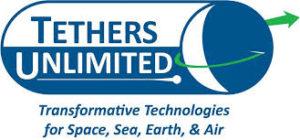I have written about Tethers Unlimited (TU) before. They are a private space company located in Bothell, WA. Years ago, when they were founded, tethers were thought to hold great promise for a number of space applications. As time passed, that promise faded and so did the money available for research and development. When I saw a presentation by the head of TU last year, they were diversifying into providing satellite maneuvering thrusters using water for fuel and satellite radios that used software to set the frequency.
NASA has just handed out forty-five million dollars to support three hundred and sixty-three aerospace projects that were proposed by small businesses and research institutions. Each project has been awarded up to a one hundred and twenty-five thousand dollar Phase 1 grants as part of NASA’s Small Business Innovation Research (SBIR) and Small Business Technology Transfer (STTR). TU was awarded grants for five space technology projects. TU has been granted NASA Phase 1 grants before for such things as in-space construction and 3D printing. Here are brief descriptions of the five new TU projects.
SPIDER: When I was listening to the TU CEO talking about current research projects, he described a machine that could move around on structures in orbit and use a spool of material to create new struts for the structure. I thought to myself that that sounded like a mechanical spider. Soon after that thought occurred to me, he said that they called the construction machine a “Spider”. At TU, SPIDER now stands for Sensing and Positioning in Deep Environments With Retrieval. This new device does not fit the description that I heard at the presentation last year. This new SPIDER is intended to position itself above a lunar crater and take samples while changing position. It was developed to overcome the contamination and stability problems that can occur when a lunar rover is exploring a crater. Phase 1 funding is to support development and design. If NASA funds Phase II, a prototype will be developed and tested.
ARTIE: ARTIE stands for Androgynous Robotic Tool-change Interface. It is intended to supply power and data interface to the connectors on robot arms used in space. Phase I will consist of demonstration of a proof of concept prototype. If NASA grants Phase II for ARTIE, a prototype will be sent into orbit for testing.
VORTEX: VORTEX stands for Venus or Titan Exploration. This is a gimballed pointing mechanism or artificial “wrist” that would be use for Venus and/or Titan explorations as well as satellite operations in other extreme environments. Phase I funds will be to support progress in the design of ARTIE.
HyperBus: The HyperBus Cargo Platform is a palletized system for the transport, emplacement and exchange of hardware at the International Space Station or other orbital platforms. If TU gets to Phase II on this project, funding will be used to develop the concept, construct a prototype and demonstrate the system in the TU laboratory.
RAMP TPS: RAMP TPS stands for Resin Additive Manufacturing Processed Thermal Protection System. Phase I funding will support development of an in-situ cured, additively manufactured, spacecraft heatshield material and process. This device will allow the lost-cost manufacture of heat shields in orbit for re-entry vehicles. TU and Western Washington University will collaborate on the creation of this technology.
